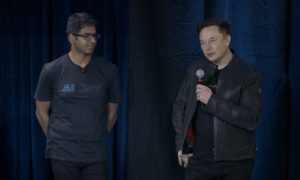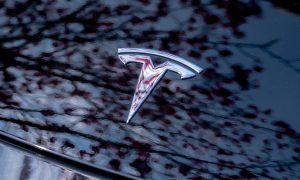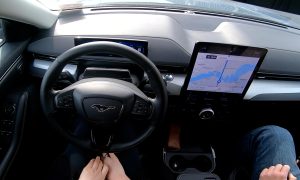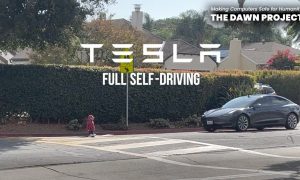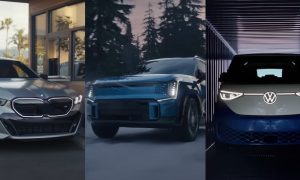News
Tesla asked by NHTSA to furnish Autopilot data logs [Updated]
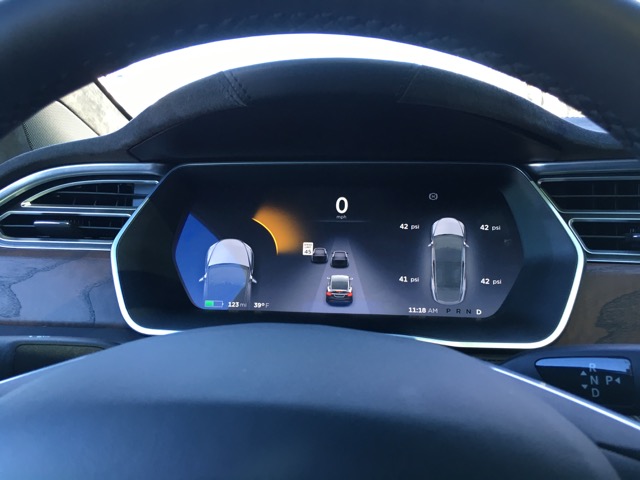
The National Highway Transportation Safety Administration has sent Tesla Motors a 9 page letter asking for specifics about any modifications to the Autopilot system including software changes that Tesla has made since Autopilot was first rolled out in the fall of 2015.
Updated: We received a copy of the 9-page letter sent by the NHTSA to Tesla outlining details on the type of information Tesla must hand over.
At issue is how the system detects and reacts to cross traffic. The probe is related specifically to the crash that killed Joshua Brown on a Florida highway on May 7. His car was operating on Autopilot when it struck the side of a tractor trailer that was crossing the road in front of it. Tesla says the cameras on Brown’s Model S failed to distinguish the white side of the tractor trailer from a brightly lit sky. As a result, the car did not brake automatically.
According to ABC News, the letter is asking for information about how Autopilot reacts when proceeding through intersections where there is cross traffic. Its request also asks the company to describe how the system determines if the input from cameras and other sensors is “compromised or degraded” in any way, and how the problems are communicated to the driver.
Lastly, the NHTSA has given Tesla an August 26 deadline to turnover details of all known crashes, consumer complaints, and lawsuits filed or settled because the Autopilot system didn’t brake as expected. Agency spokesperson Bryan Thomas says the information requested is a routine part of an investigation and the agency has not yet determined whether Autopilot constitutes a safety risk.
Elon Musk told the Wall Street Journal on Tuesday that Tesla has no plans to disable its Autopilot feature in the wake of the fatal crash in Florida. Musk responded by saying that the company is planning an explanatory blog post to educate customers on how Autopilot works. “A lot of people don’t understand what it is and how you turn it on,” he said. Musk is a fierce supporter of the Autopilot system and claims it has already proven to be safer than a human driver.
All of this comes as more details are emerging about a crash in Montana involving a Model X that reportedly veered off a country road. The driver told the Montana state police he had initiated Autopilot, but Tesla says the vehicle log shows only auto steer was activated. The car’s computer detected no force on the steering wheel for more than two minutes. If there’s no force on the wheel or a sharp turn is detected, the vehicle is programmed to gradually reduce speed, stop, and turn on the emergency lights, Tesla said in a statement.
The company said the Model X alerted the driver to put his hands on the wheel, but he didn’t do it. “As road conditions became increasingly uncertain, the vehicle again alerted the driver to put his hands on the wheel. He did not do so and shortly thereafter the vehicle collided with a post on the edge of the roadway,” the statement said. It isn’t clear whether the Model X had made a decision to stop at the time of the crash.
The car traveled around a right hand curve, then went off the road. It traveled about 200 feet on the narrow shoulder, taking out 13 posts, said trooper Jade Shope. No citation was issued to the drivers because the trooper believed any citation would be void if the car was operating on Autopilot as claimed by the driver. That is a fairly curious position for a law enforcement officer to take, since there is no way for authorities to determine at the scene of an accident whether Autopilot actually was or was not activated.
The National Transportation Safety Board has also opened an investigation of the Florida crash. It is entirely possible that some new regulations regarding autonomous driving systems in general will result from the combined NHTSA/NTSB review.
News
Tesla begins Robotaxi certification push in Arizona: report
Tesla seems serious about expanding its Robotaxi service to several states in the coming months.

Tesla has initiated discussions with Arizona transportation regulators to certify its driverless Robotaxi service in the state, as per a recent report from Bloomberg News. The move follows Tesla’s launch of its Robotaxi pilot program in Austin, Texas, as well as CEO Elon Musk’s recent comments about the service’s expansion in the Bay Area.
The Arizona Department of Transportation confirmed to Bloomberg that Tesla has reached out to begin the certification process for autonomous ride-sharing operations in the state. While details remain limited, the outreach suggests that Tesla is serious about expanding its driverless Robotaxi service to several territories in the coming months.
The Arizona development comes as Tesla prepares to expand its service area in Austin this weekend, as per CEO Elon Musk in a post on X. Musk also stated that Tesla is targeting the San Francisco Bay Area as its next major market, with a potential launch “in a month or two,” pending regulatory approvals.
Tesla first launched its autonomous ride-hailing program on June 22 in Austin with a small fleet of Model Y vehicles, accompanied by a Tesla employee in the passenger seat to monitor safety. While still classified as a test, Musk has said the program will expand to about 1,000 vehicles in the coming months. Tesla will later upgrade its Robotaxi fleet with the Cyercab, a two-seater that is designed without a steering wheel.
Sightings of Cybercab castings around the Giga Texas complex suggests that Tesla may be ramping the initial trial production of the self-driving two-seater. Tesla, for its part, has noted in the past that volume production of the Cybercab is expected to start sometime next year.
In California, Tesla has already applied for a transportation charter-party carrier permit from the state’s Public Utilities Commission. The company is reportedly taking a phased approach to operating in California, with the Robotaxi service starting with pre-arranged rides for employees in vehicles with safety drivers.
News
Tesla sets November 6 date for 2025 Annual Shareholder Meeting
The automaker announced the date on Thursday in a Form 8-K.

Tesla has scheduled its 2025 annual shareholder meeting for November 6, addressing investor concerns that the company was nearing a legal deadline to hold the event.
The automaker announced the date on Thursday in a Form 8-K submitted to the United States Securities and Exchange Commission (SEC). The company also listed a new proposal submission deadline of July 31 for items to be included in the proxy statement.
Tesla’s announcement followed calls from a group of 27 shareholders, including the leaders of large public pension funds, which urged Tesla’s board to formally set the meeting date, as noted in a report from The Wall Street Journal.
The group noted that under Texas law, where Tesla is now incorporated, companies must hold annual meetings within 13 months of the last one if requested by shareholders. Tesla’s previous annual shareholder meeting was held on June 13, 2024, which placed the July 13 deadline in focus.
Tesla originally stated in its 2024 annual report that it would file its proxy statement by the end of April. However, an amended filing on April 30 indicated that the Board of Directors had not yet finalized a meeting date, at least at the time.
The April filing also confirmed that Tesla’s board had formed a special committee to evaluate certain matters related to CEO Elon Musk’s compensation plan. Musk’s CEO performance award remains at the center of a lengthy legal dispute in Delaware, Tesla’s former state of incorporation.
Due to the aftermath of Musk’s legal dispute about his compensation plan in Delaware, he has not been paid for his work at Tesla for several years. Musk, for his part, has noted that he is more concerned about his voting stake in Tesla than his actual salary.
At last year’s annual meeting, TSLA shareholders voted to reapprove Elon Musk’s compensation plan and ratified Tesla’s decision to relocate its legal domicile from Delaware to Texas.
Elon Musk
Grok coming to Tesla vehicles next week “at the latest:” Elon Musk
Grok’s rollout to Tesla vehicles is expected to begin next week at the latest.

Elon Musk announced on Thursday that Grok, the large language model developed by his startup xAI, will soon be available in Tesla vehicles. Grok’s rollout to Tesla vehicles is expected to begin next week at the latest, further deepening the ties between the two Elon Musk-led companies.
Tesla–xAI synergy
Musk confirmed the news on X shortly after livestreaming the release of Grok 4, xAI’s latest large language model. “Grok is coming to Tesla vehicles very soon. Next week at the latest,” Musk wrote in a post on social media platform X.
During the livestream, Musk and several members of the xAI team highlighted several upgrades to Grok 4’s voice capabilities and performance metrics, positioning the LLM as competitive with top-tier models from OpenAI and Google.
The in-vehicle integration of Grok marks a new chapter in Tesla’s AI development. While Tesla has long relied on in-house systems for autonomous driving and energy optimization, Grok’s integration would introduce conversational AI directly into its vehicles’ user experience. This integration could potentially improve customer interaction inside Tesla vehicles.
xAI and Tesla’s collaborative footprint
Grok’s upcoming rollout to Tesla vehicles adds to a growing business relationship between Tesla and xAI. Earlier this year, Tesla disclosed that it generated $198.3 million in revenue from commercial, consulting, and support agreements with xAI, as noted in a report from Bloomberg News. A large portion of that amount, however, came from the sale of Megapack energy storage systems to the artificial intelligence startup.
In July 2023, Musk polled X users about whether Tesla should invest $5 billion in xAI. While no formal investment has been made so far, 68% of poll participants voted yes, and Musk has since stated that the idea would be discussed with Tesla’s board.
-

 Elon Musk1 week ago
Elon Musk1 week agoTesla investors will be shocked by Jim Cramer’s latest assessment
-

 Elon Musk3 days ago
Elon Musk3 days agoElon Musk confirms Grok 4 launch on July 9 with livestream event
-

 Elon Musk17 hours ago
Elon Musk17 hours agoxAI launches Grok 4 with new $300/month SuperGrok Heavy subscription
-

 News7 days ago
News7 days agoTesla Model 3 ranks as the safest new car in Europe for 2025, per Euro NCAP tests
-

 Elon Musk2 weeks ago
Elon Musk2 weeks agoA Tesla just delivered itself to a customer autonomously, Elon Musk confirms
-

 Elon Musk1 week ago
Elon Musk1 week agoxAI’s Memphis data center receives air permit despite community criticism
-

 Elon Musk2 weeks ago
Elon Musk2 weeks agoTesla’s Omead Afshar, known as Elon Musk’s right-hand man, leaves company: reports
-

 News2 weeks ago
News2 weeks agoXiaomi CEO congratulates Tesla on first FSD delivery: “We have to continue learning!”


